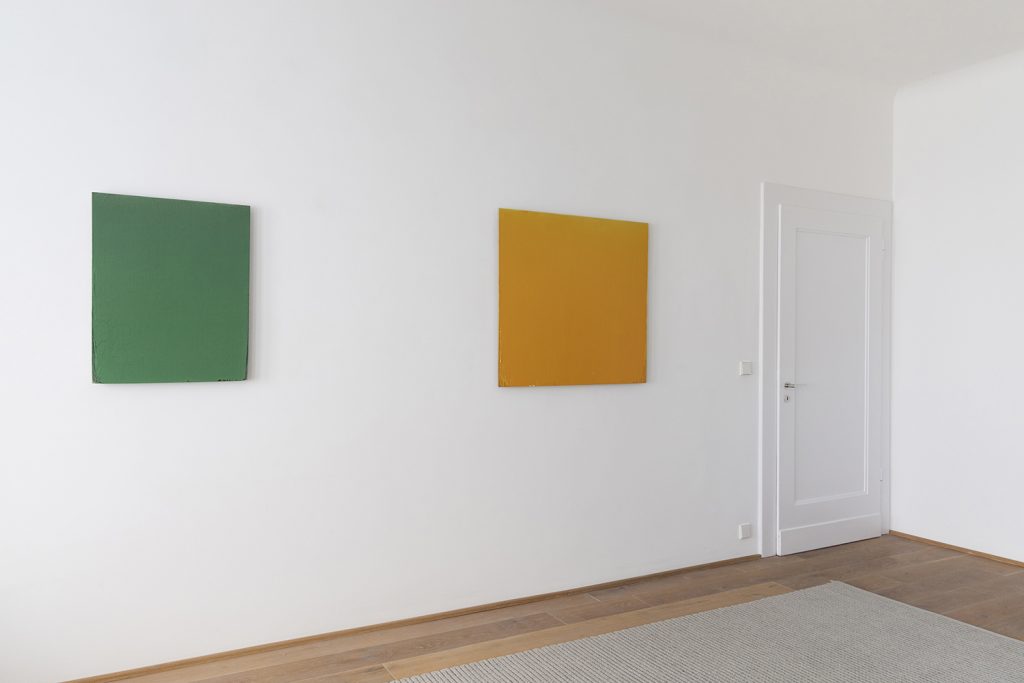JOSEPH MARIONI
April 30 – August 18, 2023





Photos: Dirk Wüstenhagen
The English word “colour” derives from the Latin *celare*, meaning “to hide”. The Romans believed that colour concealed what lay beneath it. In contrast, the European pictorial tradition sees colour as a means of revelation. Unlike in previous centuries, the focus has recently shifted from revealing narrative or meaning about the world to the act of painting itself. Since the 1950s, New York painters have understood painted colour not as an additive placement of spots, fields, or individual gradients, but as the result of a performance, a painting process in which the entire picture field is methodically explored. Pollock conquered the pictorial space with physical gestures by letting and hurling paint, Morris Louis let various bright colours merge from the edge of the canvas into a cloud of colour, Rothko focused on two or three colours that he layered in rectangular fields and allowed to breathe towards the edges, Newman freely extended colour against a subjectively drawn boundary, and Clifford Still pushed it bit by bit towards the upper edge. Joseph Marioni is in this tradition. His disclosure of the painting act aims not only to make the painting act itself transparent but also to condense everything sayable in painting into a primal contrast and a primal unity: that of luminosity and painterly body.
The painterly body is an interplay of pigment, the fluid medium in which the pigment is bound, and the support surface that absorbs, binds, and allows itself to be covered by the medium. Marioni’s painterly development can be discerned in how he has unfolded these different factors to one another. For him, the basis is the individual pigment, which consists of its material body. (This body can be indirectly read from the fine flowing traces and droplets found on all his paintings.) The pigment is bound into a liquid medium, which allows the physical body free expansion. This can be seen in the flow behavior of the paint on the surface, especially at the four edges of the paintings, which Marioni designs differently. The lower edge of the picture, with its delicate pictorial droplets, makes the flow behavior obvious. The right and left edges of the picture, in their distinctness, address not only our oriented bodily sense of right and left but also the sensory contact with the world that penetrates into us beyond the boundary of our body. At the upper edge of the picture, it becomes apparent that Marioni does not start the paint at the edge like Morris Louis, but consciously leads it painterly to the edge. Most of his paintings are lighter at the top or stand out from a darker background there. In Marioni’s work, the painted colour is thus an experience of the interplay of unrestrained expansion and breadth and a reflection on physical boundaries.
In his more recent work, he advances the dematerialization of the pigment body of the colour by dissolving the pigment into ever finer glazes and enhancing the inexplicable reflective power of light in the different colour values and layered overlays into a magical sensual expressiveness. Initially, Joseph Marioni’s work focused on juxtaposing archetypes of color. Over the course of his career, which now spans more than five decades, he has increasingly aimed to demonstrate that these color archetypes share a common foundation in the cosmos of color relationships and in the emission of light, which can only be captured and absorbed by our bodily sensory apparatus. The color is intended to radiate luminously, to unify and present the entirety of appearance for our capacity to feel, for our body as a concentration of the senses. All seeing is a response to light, and light splits into colors. However, the way colors develop a very different liveliness and radiance in an overlay of different color values cannot be explained merely through the addition or subtraction of light wavelengths but represents a magical process that can only be explained through a prolonged development of sensitivities to the nuances of our life. In each color type, the other colors also appear indirectly in latent oppositions. But how these fine relationships with their very different appeals can unfold is recorded in Marioni’s layered color layers, yet at the same time, it remains elusive. The result of layering the color is a physical process that we as viewers must actively participate in by sensing the color in its holistic radiance visually and through the open porosity of the picture edges as a skin sensation on and in our body. Marioni’s paintings are body portraits of the luminous appearance of the world, where narrative details of the world are overshadowed in favor of the general wonder of visibility. The tangible details of the world are dissolved in the act of grasping the basis of our perception. The painting process transforms into a self-presentation of perception. Based on this fundamental union of light and body in the pictorial representation, we aim to unfold a network of relationships in our exhibition, where the contrast of space, body, and picture plane appears to be nullified. On the occasion of Joseph Marioni’s 80th birthday, we present his latest works, in which the light in his painting has found an increasingly spiritual yet simultaneously bodily form.
Rolf Hengesbach
